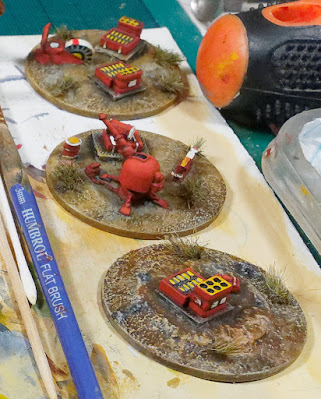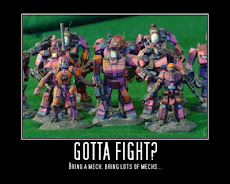This post is the start of a number of articles describing what makes Big Little Wars different, or unique from, all the other SF wargames out there for players to choose from. I mean, why bother getting my rules rather than say, Warhammer 40K, BattleTech, or Heavy Gear?
They're all clearly SF wargames that feature mecha in some shape or form. And you all know I love mecha.
One word, plausibility; with an emphasis on command and control.
All right, three words: plausibility, command, and control; in a near future setting.
Okay that's actually five words: plausibility, command, control, near future setting.
Enough of the Monty Python routine, what about the science!?
I mean it's science fiction, otherwise it would just be historical wargaming dressed up with science-fictional buzz words. In other words, a game that lacks any awesomely mind-boggling futuristic science; just the same as every other SF game on the market. Yeah, I hear you, dragons, or insert X here, are cool!
But, there are already a plethora of future-science-is-magic wargames, and therefore my rules may not be for you.
Still, any advanced science will be indistinguishable from magic, unless you understand the science. Therefore, the rules will exploit advance science that appears to be magic, but which isn't magic. Okay?
Is it going to be Vietnam in space; just another bug hunt, ma'am?
No it's not.
Come and see me later for some attitude correction. Or read the rest of this post, or both. Give me twenty...
Seriously, no.
The aim of the rules is to provide plausible, playable, combine arms wargames with Command, Control, Communications, Computers, Intelligence, Surveillance, and Reconnaissance (C4ISR). Yep that's sixteen words. You can see why I didn't lead with that.
The 'how of the game' is built on the foundations from Too Fat Lardies Chain-of-Command rules.
Specifically on how to manage the command and control. However, the combat resolution system does not involve buckets of dice (a personal bugbear of mine; though a perfectly valid choice).
But, on top of that the rules will provide players with guidelines to create an army, and encourages players to play with their favourite models, whatever figures size they have can be accommodated.
Other points to bear in mind, there will be mechanisms that treat the meta (no not that meta, the other meta*) of toy soldier wargames.
The current draft of Big Little Wars has turned some preconceptions about seeing where a model is on the table versus where the it actually is i.e: the playing table is just a map showing where the players sensors think everything is. This beds the game into the whole Fog-of-War, and emphasizes the asymmetrical nature of the battles of tomorrow.
This is also me taking a leaf out of quantum mechanics.
Yep, I've said the Q word (quantum voodoo is cool), and by using a scientific concept of uncertainty. Until an object is measured (attacked) the location of the model is uncertain, which adds a science fictional feature to the game.
So, that's all for now, catch y'all on the bounce.
*Meta Notes:
Traditional meaning beyond, after, or “behind e.g: metaphysics (beyond or after physics).
Wargaming acronym i.e: Maximally Effective Tactics Available.
Modern accepted use of meta means information about information e.g: metadata, or in this case what the position of a toy soldiers when placed on the tabletop actually represents (its information).














.png)




